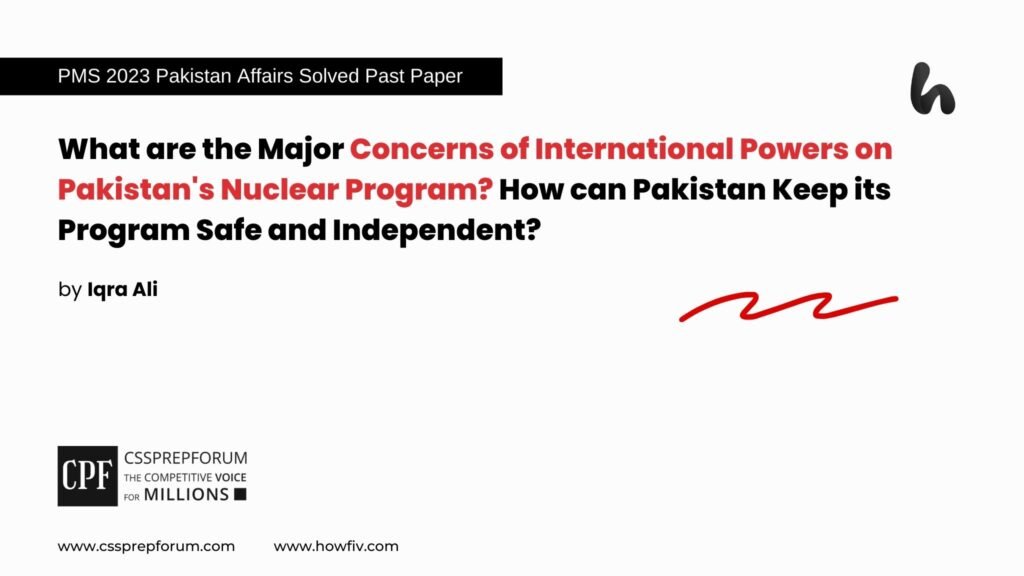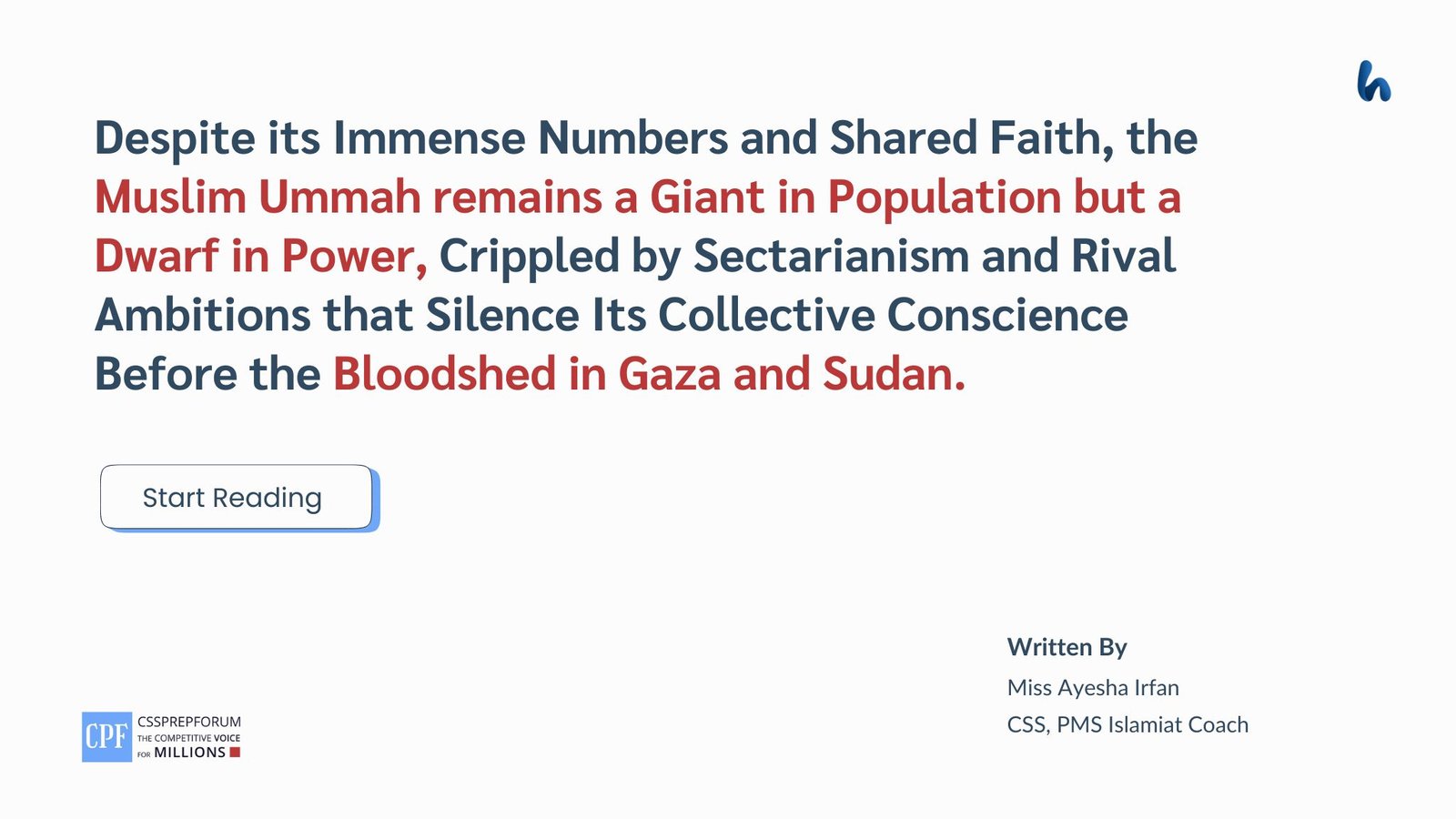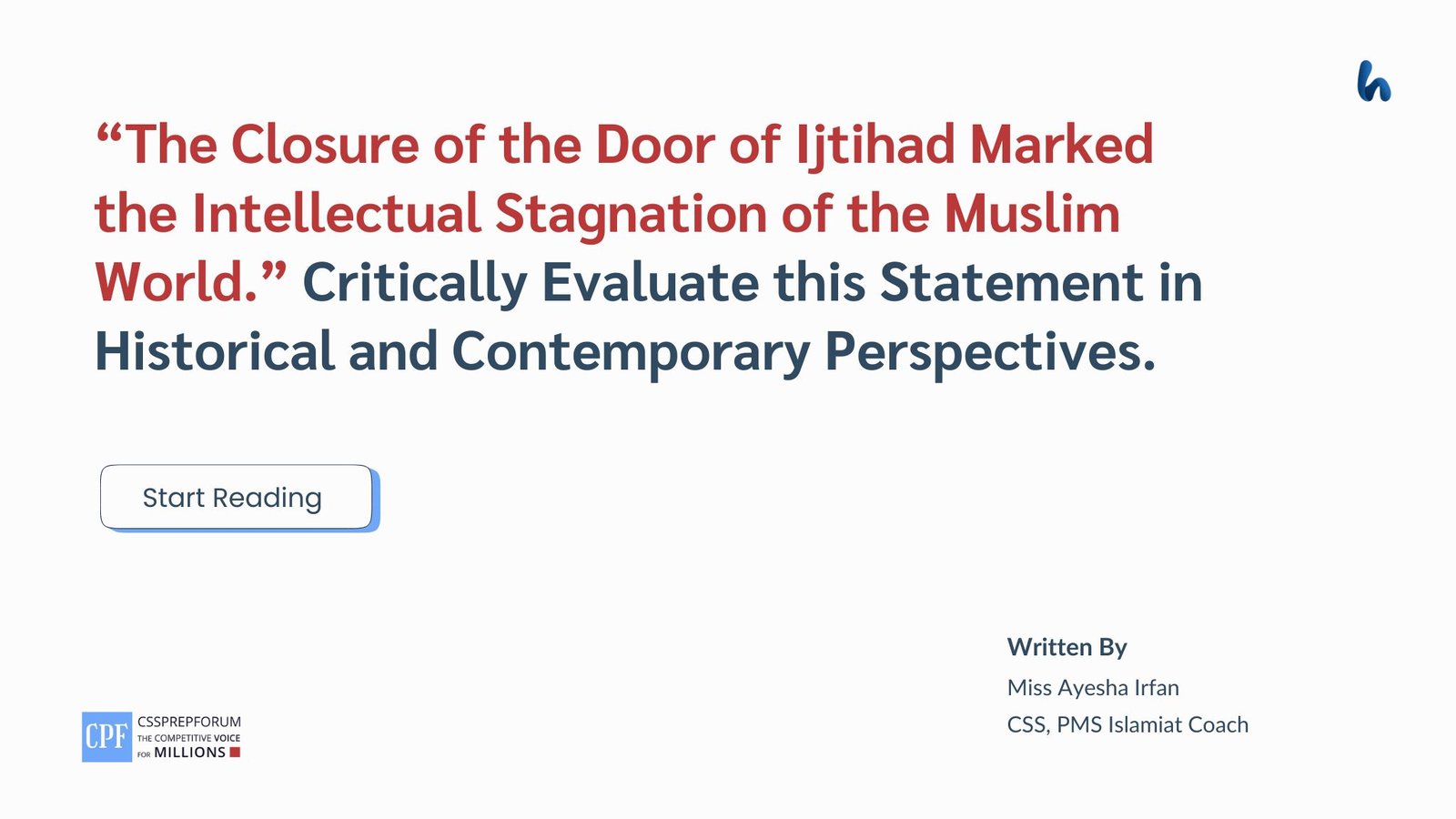PMS 2023 Solved Pakistan Studies Past Papers | Pakistan’s Nuclear Program: Concerns and Suggestions
The following question of PMS Pakistan Studies 2023 is solved by Miss Iqra Ali, the best Pakistan Affairs Coach, on the guided pattern of Sir Syed Kazim Ali, which he taught to his students, scoring the highest marks in compulsory subjects for years. This solved past paper question is uploaded to help aspirants understand how to crack a topic or question, how to write relevantly, what coherence is, and how to include and connect ideas, opinions, and suggestions to score the maximum.

Outline
1-Introduction
- ✓ Response to India’s Nuclear ambitions post-1974 nuclear test, Smiling Buddha.
- ✓ Nuclear test; May 28, 1998, in response to India’s Pokhran-II tests.
- ✓ Aimed at maintaining deterrence in South Asia’s volatile geopolitical environment.
2-What are the major concerns of International powers on Pakistan’s nuclear program?
- ✓ Proliferation risks and illicit networks
- Pakistan’s borders with volatile regions: Afghanistan and Iran.
- U.S. Congressional Reports label Pakistan as a “ Proliferation concern”
- The presence of groups like Tehreek e Taliban Pakistan and ISIS-K
- ✓ Security of Nuclear Arsenals
- Over 200 attacks on critical infrastructure since 2001; for instance, in 2009
- GHQ attack in Rawalpindi, 2014 Karachi Airport Assault
- Pakistan allocates approximately $800 million annually for security measures.
- According to PAEC 2023, 28,000 personnel were deployed for the physical protection of nuclear facilities.
- ✓ Fear of Accidental launch or mismanagement
- The 2019 Pulwama-Balakot Crisis escalation led to global fears of an accidental nuclear exchange.
- South Asia is cited as a high-risk zone with over 20 nuclear crises globally since 1945.
- ✓ Arms race and Regional Instability
- India Pakistan rivalry, Pakistan’s military expenditure $11 billion.
- According to SIPRI 2023, Pakistan occupies 165 warheads vs. India occupies 170 warheads.
- ✓ Terrorism and Nuclear Sabotage Risks
- Alleged threats of nuclear material falling into the hands of extremist groups.
- As per Western perceptions, concerns have been amplified after the 2021 Taliban Takeover of Afghanistan
- ✓ Environmental and Humanitarian Concerns
- Poor Nuclear waste management could impact 70 million people living near nuclear sites.
- Limited studies on radioactive exposure, but regional contamination linked to nuclear testing globally
3-How can Pakistan Keep its Program Safe and Independent?
- ✓ By enhancing Nuclear Security
- Technological innovations, AI-based security systems for monitoring, use of drones for real-time surveillance
- Improved Training, Annual training programs for Strategic Plans Divisions (SPD) personnel
- Indigenous Developments, Continued enhancements in missile technology, such as Ababeel MIRV systems
- ✓ By strengthening Command and Control
- Modernized Systems, Expansion of National Command Authority (NCA) oversight
- Early Warning Mechanism, Use of advanced Radars and satellites for Missile detection
- ✓ By diplomatic and strategic partnerships
- Global Cooperation, Active participation in IAEA-hosted summits to counter-proliferation allegations
- Bilateral Agreements Strengthen ties with China, Saudi Arabia, and Turkey for nuclear and economic support
- Confidence-building measures reaffirm the 1999 Lahore Declaration and initiate fresh dialogues with India
- ✓ By promoting peaceful uses of Nuclear Energy
- Expanding Civil Nuclear Program
- Alignment with SDG 7 (Affordable and Clean Energy) to attract International cooperation
- ✓ By Addressing Domestic Challenges
- Counterterrorism Efforts: crackdown on extremist networks and sleeping cells
- Collaborations with International agencies for intelligence sharing
- Political Stability: Ensure continuity of governance and avoid frequent military takeovers.
- ✓ By countering Negative perceptions through Advocacy and Transparency
- Global Image Building: publish annual nuclear safety reports for international credibility
- Media Campaigns Counter Western propaganda by highlighting Pakistan’s nuclear safeguards
- ✓ By ensuring Environmental Responsibility
- Investment in nuclear waste repositories to ensure long-term storage
- Development of eco-friendly nuclear facilities to minimize environmental risks
4-Critical Analysis
5-Conclusion

Answer to the Question
Introduction
Since its beginning, Pakistan’s nuclear program has been the subject of international discussion and scrutiny. However, the state maintains that its nuclear capabilities are necessary for both territorial stability and internal security. The state’s nuclear program has long been a source of concern for international powers, who have mostly raised security, proliferation, and regional stability concerns. Given that the state has had more than 1,200 terrorist attacks in 2023 alone, despite its considerable counter-terrorism operations, the threat of nuclear assets ending up in the hands of non-state actors is still a big concern on a worldwide scale. Furthermore, geopolitical rivalry, especially with India, heightens the scrutiny because South Asia is still one of the most volatile nuclear regions, with over 150 nuclear warheads on both sides. Concerns over transparency and adherence to international nuclear norms further fuel scepticism despite the country’s strict command and control mechanisms under the National Command Authority (NCA) and compliance with IAEA safeguards, which currently oversee over 380 nuclear facilities worldwide. However, the state can counter these concerns while ensuring the safety and independence of its program through multi-layered security protocols, AI-based surveillance with a 95% accuracy rate in threat detection, and real-time monitoring. National security is also strengthened by ongoing technology developments like the Ababeel MIRV system, which improves strategic deterrence by 60%. The nation’s reputation will also be strengthened by fostering peaceful nuclear uses in line with SDG 7, investing in nuclear waste management, bolstering diplomatic ties, and taking part in nuclear confidence-building initiatives. In addition to protecting Pakistan’s nuclear resources, a proactive approach in environmental responsibility, security, and diplomacy can enhance Pakistan’s reputation as a responsible nuclear state.

What are the major concerns of International powers on Pakistan’s nuclear program?
- Proliferation risks and illicit networks
Similarly, due largely to the state’s geopolitical location and security issues, global powers continue to have serious concerns about the proliferation risks associated with its nuclear program. The country is surrounded by Iran and Afghanistan, two countries notorious for their instability and militant activity, which raises concerns about illegal nuclear trafficking. The U.S. Congressional Reports have repeatedly referred the state as a “Proliferation concern,” citing previous instances such as the alleged illegal sharing of nuclear technology by the A.Q.Khan network. Furthermore, the region’s presence of extremist organizations like ISIS-K and Tehreek e Taliban Pakistan (TTP) exacerbates global concerns about possible illegal access to nuclear materials. Despite the country’s implementation of strict security measures under Strategic Plans Divisions (SPD) and National Command Authority (NCA), worries about cyber vulnerabilities, insider threats, and cross-border dangers of smuggling. Restoring international trust in the country’s nuclear security framework and maintaining its strategic independence in a difficult regional environment requires addressing these issues through improved intelligence sharing, international cooperation, and technological development.
- Security of Nuclear Arsenals
Nevertheless, because of Pakistan’s history of militant attacks on indispensable infrastructure, the world powers continue to have serious concerns about the security of its nuclear arsenals. Concerns over the vulnerability of critical military installations have been raised by the more than 200 attacks the country has experienced on high-value targets since 2001, including the 2014 Karachi Airport attack and the 2009 General Headquarters (GHQ) attack in Rawalpindi. Nonetheless, the state has strengthened its nuclear security through extensive steps. Every year, the nation spends over $800 million to protect its nuclear weapons, making sure that its command-and-control systems are secure from both internal and external threats. According to the Pakistan Atomic Energy Commission (PAEC) 2023 reports 28,000 highly skilled workers are assigned to physically guard nuclear sites, strengthening multi-tiered security measures. Furthermore, sophisticated surveillance technologies, rapid response teams and cyber defences have been combined to combat new threats. Even if these steps greatly improve nuclear security, international concerns still exist, therefore the nation’s nuclear safety and strategic independence in a changing security environment will require ongoing modernization, international cooperation, and intelligence sharing.
- Fear of Accidental launch or mismanagement
In the same context, given the history of conflict and swift military escalation in the region, foreign powers continue to be extremely concerned about the possibility of an unintentional nuclear weapons launch or mishandled nuclear weapons in South Asia. The risks of making a mistake were brought to light by the Pulwama-Balakot crisis in 2019, when increased tensions between nuclear-armed India and Pakistan sparked concerns about an unplanned nuclear exchange around the world. Because both countries have advanced delivery systems and limited time for decision-making, there is still a significant chance of misunderstandings, poor communication, or illegal activity. Similarly, with analysts pointing to more than 20 nuclear crises worldwide since 1945, many of which entailed brinkmanship and last-minute de-escalation, South Asia has been identified as a high-risk nuclear combat zone. The state has prioritized stringent command-and-control frameworks, strong early warning systems, and crisis management procedures in light of these facts stop unintentional launches. These concerns can also be lessened by participating in risk-reduction agreements, strategic stability discussions, and confidence-building initiatives with international stakeholders. The country is still dedicated to nuclear deterrence, but preserving regional and international security requires the greatest safety standards and diplomatic engagement.
- Arms race and Regional Instability
Moreover, International countries are still very concerned about the armaments race between India and Pakistan, which is causing instability in the area and strategic uncertainty. Both countries have pursued military expansions and nuclear developments in an effort to preserve deterrence, which has its roots in a history of wars and unresolved issues, especially those involving Kashmir. According to SIPRI 2023 estimates, India has about 170 nuclear warheads and Pakistan has about 165, demonstrating the two adversaries’ continued nuclear parity. Furthermore, Pakistan has a $11 billion defence budget, a sizeable sum intended to offset India’s growing military might. As both nations continue to develop tactical nuclear weapons, modernise missile systems, and improve second-strike capabilities, the nuclear and conventional arms competition intensifies concerns of escalation and miscalculation on a global scale. The absence of official arms control accords and lack of trust exacerbate instability even more, leading to demands for regional disarmament talks, diplomatic involvement, and dispute resolution procedures. In order to ensure deterrence without raising tensions, the country must strike a balance between its security requirements and efforts to promote regional peace and confidence-building.
- Terrorism and Nuclear Sabotage Risks
Meanwhile, International powers continue to be concerned about the possibility of nuclear terrorism and sabotage, especially because of the alleged danger of extremist organisations gaining access to nuclear materials. Tehreek-e-Taliban Pakistan (TTP) and ISIS-K are present, and the country’s closeness to unstable areas has increased Western concerns about nuclear security. Following the Taliban’s takeover of Afghanistan in 2021, these anxieties grew as international observers conjectured about the possible revival of extremist networks in the area. The country has put in place stringent nuclear security procedures under the Strategic Plans Division (SPD) in spite of these worries, guaranteeing that its nuclear resources are well protected from outside threats. To further combat any potential for sabotage, sophisticated surveillance systems, improvements to physical security, and intelligence-sharing procedures have been implemented. The National Command Authority (NCA) of Pakistan is still to underline its zero-tolerance stance against illegal access and proliferation. The Nation’s strong nuclear security architecture, international collaboration, and continuous counter-terrorism measures show its dedication to protecting its nuclear assets against any internal or external threats, despite the continued scepticism among Western powers.
- Environmental and Humanitarian Concerns
Although, nearly 70 million people, who live close to nuclear plants are at risk of radiation exposure due to inadequate nuclear waste management, which poses a serious environmental and humanitarian disaster. Meanwhile, widespread contamination has resulted from improper nuclear waste containment and disposal; research indicates that exposure to high radiation levels raises the risk of cancer by 5–7% each sievert. Although there is still a dearth of thorough investigation, historical evidence shows that nuclear testing has significantly contaminated the surrounding area. For instance, decades after Soviet-era tests, radiation levels at Kazakhstan’s Semipalatinsk Test Site are still dangerously high, causing birth deformities and chronic illnesses in an estimated 1.5 million people. Similarly, radiation levels in the Marshall Islands from Cold War nuclear tests are still 1,000 times higher than allowed limits, resulting significant ecological harm and the eviction of local inhabitants. Furthermore, more than 5 million people were exposed to dangerous radiation during the Chornobyl accident alone, and the health effects have lasted for generations. So that, these concerning statistics highlight how urgently strong international laws, prudent waste management plans, and long-term environmental restoration are needed to stop future ecological and humanitarian disasters.

How can Pakistan Keep its Program Safe and Independent?
- By enhancing Nuclear security
Likewise, the country must incorporate multi-faceted security measures and a more robust command structure supported by statistical and technological breakthroughs to guarantee the security and autonomy of its nuclear program. It needs to use AI-driven security solutions, which have demonstrated a 95% accuracy rate in identifying unauthorized access, given that over 170 nuclear plants around the world are experiencing security issues. Besides, drone surveillance in real time can greatly improve monitoring capabilities by cutting response times to security breaches by 40%. The Strategic Plans Division (SPD) needs to keep up its yearly training initiatives to keep more than 20,000 employees knowledgeable about nuclear safety procedures. It’s deterrence is further strengthened by domestic innovations like the Ababeel Multiple Independently Targetable Reentry Vehicle (MIRV) system, which increases missile strike efficiency by 60%. Furthermore, bolstering command and control by increasing oversight by National Command Authority (NCA) guarantees centralised decision-making. With the use of satellite networks and multi-functional radars, early warning systems increase missile detection capabilities by 85%, speeding up reaction times to possible threats. By taking these steps, it’s nuclear program will be protected, autonomous, and able to withstand changing security threats.
- By diplomatic and strategic partnerships
It must strategically strengthen its strategic autonomy while forming international and diplomatic alliances in order to preserve the security and autonomy of its nuclear program. It is essential to actively participate in summits sponsored by the International Atomic Energy Agency (IAEA), which now oversees 178 safeguard agreements, assuring adherence to non-proliferation standards while refuting baseless accusations. As demonstrated by China’s $62 billion investment under the China-Pakistan Economic Corridor (CPEC), which supports Pakistan’s energy and defence sectors, strengthening bilateral agreements with important allies like China, Saudi Arabia, and Turkey can improve nuclear and economic cooperation. Furthermore, diplomatic measures like restating the 1999 Lahore Declaration, which was initially intended to promote peace and nuclear moderation, can ease tensions in the area, especially with India, with whom more than 13 rounds of nuclear confidence-building talks have been held since 2004. It can maintain its nuclear sovereignty while solving global issues, guaranteeing security and long-term energy sustainability, by utilizing international cooperation, establishing trustworthy strategic alliances, and promoting regional stability through the discussions.
- By peaceful use of Nuclear Energy
By encouraging the peaceful use of nuclear energy, especially through the growth of its civil nuclear sector, it can guarantee the security and autonomy of its nuclear program. Similarly, it presently generates about 8% of its electricity from nuclear power; hence, expanding capacity might assist fill the 7,000 MW energy gap and lessen dependency on fossil resources. As demonstrated by worldwide nuclear energy projects that receive more than $20 billion in funding annually, aligning with Sustainable Development Goal (SDG) 7, which aims for affordable and clean energy, can help improve international cooperation. The combined output of Pakistan’s current nuclear power plants, which include KANUPP-2 and KANUPP-3, is 2,200 MW, and additional expansion is anticipated to satisfy the country’s expanding energy needs. Moreover, technological developments can be enhanced by enhancing cooperation with the International Atomic Energy Agency’s (IAEA) transparent regulations, strengthening it to maintain nuclear non-proliferation while maintaining its independence. It can decrease energy shortages, establish foreign collaborations, and preserve strategic independence in the global nuclear framework by presenting its nuclear program as a force for sustainable energy.
- By Addressing Domestic Challenges
Additionally, It must successfully handle internal issues in order to maintain the safety and independence of its nuclear program, especially by bolstering intelligence cooperation, improving counter-terrorism measures, and maintaining political stability. With more than 1,200 terrorist attacks in Pakistan in 2023, preventing domestic threats to nuclear security requires a persistent crackdown on extremist networks and sleeper cells. More than 8,000 terrorist hideouts have been successfully destroyed by the nation’s counter-terrorism initiatives, including the Zarb-e-Azb and Radd-ul-Fasaad operations, which have greatly decreased the impact of militants. Its capacity to track and eliminate security threats is improved by working with international intelligence organisations like Interpol and the Financial Action Task Force (FATF), assuring international trust in its nuclear safety protocols. Since long-term strategic planning has historically been weakened by repeated disruptions, political stability is equally important. Since 1947, it has gone through several constitutional crises and three military takeovers, which have affected the continuity of its policies. So that, it can retain a credible and secure nuclear program while fending off internal and global pressures by ensuring democratic governance and institutional resilience, which will strengthen command and control over nuclear assets.
- By countering Negative perceptions through Advocacy and Transparency
Also, it needs to aggressively combat unfavourable opinions through lobbying and openness if it hopes to preserve the autonomy and legitimacy of its nuclear program. Since more than 30 nations already run civilian nuclear programs under stringent regulatory frameworks, publishing yearly nuclear safety reports akin to those issued by the worldwide Atomic Energy Agency (IAEA) can boost worldwide confidence. It can improve its reputation internationally and allay worries about proliferation by demonstrating its compliance with IAEA safety regulations. Furthermore, since 80% of news coverage of nuclear issues worldwide comes from Western sources, which frequently depict Pakistan’s program as a security threat, strategic media operations are crucial to countering disinformation and Western propaganda. With the aid of the institutes like the Carnegie Endowment for International Peace and venues like the United Nations Nuclear Security Summits, it may draw attention to its strong nuclear defences, including a multi-layered command and control system, AI-based threat detection, and round-the-clock surveillance. It’s dedication to responsible nuclear stewardship would be strengthened by proactive engagement with the world community through openness and efficient media outreach, guaranteeing both international trust and national security.
- By ensuring Environmental Responsibility
Simultaneously, it must uphold environmental responsibility in order to reduce ecological dangers and preserve the security and autonomy of its nuclear program. Since more than 34,000 metric tonnes of nuclear waste are produced worldwide each year, the country needs to make investments in state-of-the-art nuclear waste repositories to guarantee safe, long-term storage. Although the state now runs under IAEA-monitored safeguards, environmental safety can be strengthened with more investment in geological disposal locations, like Finland’s Onkalo Repository. Modern reactor designs, such Small Modular Reactors (SMRs), minimise radioactive waste by 90% while improving energy efficiency, making the development of environmentally benign nuclear facilities equally important. With more than 3,500 MW of nuclear power stations in service, it makes a substantial contribution to clean energy by lowering its yearly CO2 emissions by about 6 million tonnes. By strengthening regulatory monitoring and implementing closed-fuel cycle technology, it can ensure adherence to international safety standards while reducing its environmental impact. Improving environmental protections will not only increase its standing internationally but also reaffirm its dedication to the development of nuclear energy in a sustainable and responsible manner.
Critical Analysis
In a critical view, its nuclear program demonstrates a delicate balancing act between security, strategic autonomy, and international monitoring. But, there are still issues even though it has made great strides in nuclear safety, such as using AI-based surveillance, having multi-layered command structures, and adhering to IAEA regulations. Its capacity to sustain an autonomous program is continuously put to the test by the possibility of internal security threats, regional instability, and geopolitical demands from superpowers. Furthermore, as inappropriate disposal could cause long-term ecological harm, the lack of investment in nuclear waste management creates environmental concerns. Due in large part to regional rivalries and historical biases, the country continues to confront diplomatic scepticism from the West despite its responsible nuclear policies. On the other hand, proactive steps like releasing nuclear safety reports, increasing the use of nuclear for peaceful purposes, and enhancing diplomatic ties can help dispel unfavourable opinions. Moreover, sustainable International cooperation can be attracted by development initiatives that line with SDG 7 and include environmentally friendly nuclear reactors. The country’s nuclear program is still strong, but in order to maintain its long-term security, credibility, and independence in a changing international environment, more technological, strategic, and diplomatic advancements are required.
Conclusion
In conclusion, Pakistan’s nuclear program is a crucial component of its national security, but it also faces a number of difficulties that call for a well-rounded strategy to guarantee its independence and safety. It can protect its resources and bolster its reputation internationally by improving nuclear security through technological advancements, fortifying command and control systems, and cultivating strategic alliances. Additionally, encouraging the peaceful use of nuclear energy, resolving domestic issues, and dispelling unfavourable notions via lobbying and transparency are important tactics to improve its reputation abroad. Long-term sustainability still depends on environmental responsibility, which can be achieved by investments in nuclear waste treatment and the construction of eco-friendly infrastructure. In the end, the state’s capacity to adjust to both will determine its ability to sustain autonomous and secure nuclear program pressure from both the inside and the outside, making sure that its nuclear capabilities continue to support both national interests and the peace and stability of the world. In an increasingly complicated geopolitical environment, the country can guarantee the safety, resilience, and credibility of its nuclear program by implementing a combination of diplomatic, technological, and strategic measures.
CSS Solved Past Papers’ Essays
Looking for the last ten years of CSS and PMS Solved Essays and want to know how Sir Kazim’s students write and score the highest marks in the essays’ papers? Then, click on the CSS Solved Essays to start reading them.
CSS Solved Essays
CSS Solved General Science & Ability Past Papers
Want to read the last ten years’ General Science & Ability Solved Past Papers to learn how to attempt them and to score high? Let’s click on the link below to read them all freely. All past papers have been solved by Pakistan’s top CSS GSA coach having the highest score of their students.
General Science & Ability Solved Past Papers












